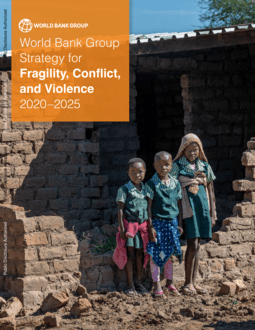Hello! You're looking at a policy document report on Overton
We track government policy, guidelines, think tank research, working papers and more to help our customers see the impact and influence of their work. Are you interested in seeing what information we have to offer? Request a free trial to our platform.
If you fund, produce or manage research or work to influence policy, we'd love to talk. Learn more on our homepage.

Identifiers
handle
10986/34858
World Bank Group Strategy for Fragility, Conflict, and Violence 20202025
World Bank Group
By 2030, more than half of the world’s extreme poor will live in countries characterized by fragility, conflict, and violence. Preventing and mitigating fragility, conflict, and violence (FCV) is central to achieving the Sustainable Development Goals (SDGs) and the World Bank Group’s (WBG) twin goals of ending extreme poverty and promoting shared prosperity. The objective of the FCV Strategy is to enhance the WBG’s effectiveness to support countries in addressing the drivers and impacts of FCV and strengthening their resilience, especially for the most vulnerable and marginalized populations.
Topics in this document
Aid
Health
Bank
Institution
Refugee
Peace
Humanitarian aid
Security
Directorate-General for European Civil Protection and Humanitarian Aid Operations
Social inequality
Gender inequality
Gender
Market (economics)
United Nations Development Programme
Global warming
Youth
Economy
Policy
Human activities
Public sphere
Politics
Corruption
International Finance Corporation
Violence
Peacebuilding
World Bank Group
Social exclusion
Climate resilience
World Bank
Remittance
Related SDGs
SDG 1: No Poverty ...
SDG 16: Peace, Justice and Strong Institutions ...
SDG 1: No Poverty
Target 1.1
Eradicate extreme poverty for all people everywhere, currently measured as people living on less than $1.25 a day
SDG 16: Peace, Justice and Strong Institutions
Target 16.1
Significantly reduce all forms of violence and related death rates everywhere
Cites research funded by
Citations
Cited by 209
other policy documents
(116 of them are from other policy sources)
